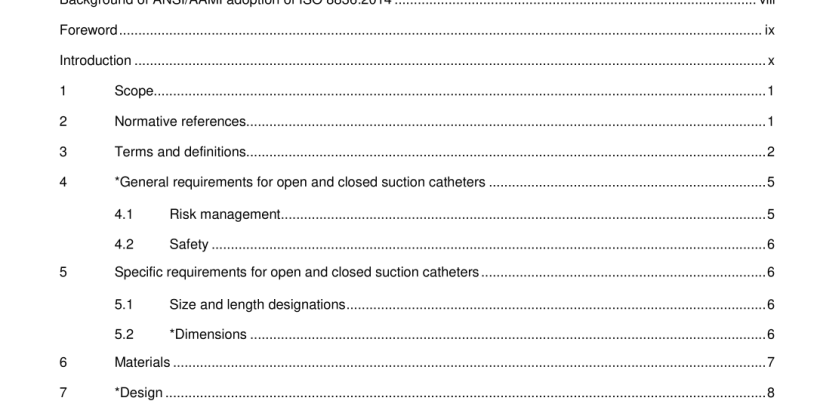ANSI AAMI ISO 8836-2015 pdf download
ANSI AAMI ISO 8836-2015 pdf download.Suction catheters for use in the respiratory tract
This annex provides a concise rationale for the important requirements of this International Standard and is intended for use by those who are familiar with the subject of this International Standard but who have not participated in its development. An understanding of the reasons for the main requirements is considered essential for its proper application. Furthermore, as clinical practices and technologies change, it is believed that rationales for the present requirements will facilitate any revisions of this International Standard necessitated by those developments. The clauses and subclauses in this annex have been so numbered to correspond to the clauses and subclauses in this International Standard to which they refer. The numbering is, therefore, not consecutive.
Closed suction catheters are used for endotracheal or artificial airway suctioning to minimize disturbance of the VBS. Closed suction catheters are provided with a protective sleeve to protect the user and the immediate environment (room surfaces, room air) and reduce the risk of contamination with secretions. At the time of publication of this International Standard, it was common practice in critical care areas to use a closed suction catheter during simultaneous mechanical ventilation of a patient. Use of a closed suction catheter allows uninterrupted mechanical ventilation without disconnection of the VBS from the tracheal tube, tracheostomy tube or other airway device. This is in contrast to the use of a traditional open suction catheter which require the opening or disconnection of the VBS before the application of the subatmospheric pressure on the respiratory tract. When used as intended, an in-line or closed suction catheter and related suction equipment become an accessory to the ventilator and an extension of the VBS. When a VBS is equipped with a suction catheter adaptor, the connector at the patient end of the closed suction catheter adaptor becomes the ‘new’ patient connection port of the VBS. Subclause 3.1 0 patient end adaptor All closed suction catheters are enclosed within a protective sleeve and a patient end adaptor designed to connect to the airway and the breathing set of the VBS. For closed suction catheters, examples of patient end adaptors may include a T-piece adaptor, Y-piece adaptor, a 3-way breathing system connector, a swivel adaptor, and other specialized adaptors for co-axial, multiple tubes, and bifurcated tubes. See also Figure 2.
Suction catheter devices should be designed in such a way that satisfies the performance, safety, clinical, and usability needs of patients and users. This section has been revised to include basic safety and essential performance and risk management principles associated with suction catheters. The need for a risk management file is a well recognized process through which the manufacturer of a medical device can identify hazards associated with a medical device, estimate and evaluate the risks associated with these hazards, control these risks, and monitor the effectiveness of that control. Clinical evaluation may also be necessary to confirm the adequacy of the controls. See ISO 1 4971 for additional information. Some elements of device design, as appropriate, may be evaluated using biophysical or modelling research whose validity has been established. Biophysical or modelling research includes the application of physics and engineering to biological processes and may include anatomical modelling or other means to simulate clinical use. Attention is drawn to the consideration of disclosure of specific labelling and instructions for intended use that might deviate from the currently accepted medical practice. Subclause 5.2 Dimensions The materials used for the manufacture of suction catheters should allow construction of a suction catheter with the thinnest possible wall, which at the same time maintains resistance to collapse and kinking.
